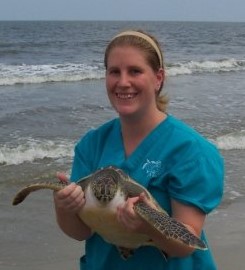Congratulations to Dr. Jeannie Martin, Lead Biology Instructor at CPTC, for her recent publication in Oryx—The International Journal of Conservation.
New Marking Methodology in Pangolin Conservation: Introducing the Pangolin Universal Notching System
Innovative Solution Provides Standardized and Widely Accessible Method to Enhance Pangolin Tracking and Conservation Efforts
Waycross, GA — Have you ever wondered how scientists manage to track some of the world's most elusive animals? For pangolins, a unique and critically endangered group of mammals, tracking has long been a challenge. Today, a new journal article is available that introduces the Pangolin Universal Notching System (PUNS), a standardized and accessible tool available to pangolin practitioners worldwide.
Pangolins, often referred to as "walking pinecones" or “scaly anteaters,” are remarkable for their distinctive scales and diet. Despite their fascinating biology, all eight species of pangolins—four native to Africa and four to Asia—are experiencing severe population declines. They are listed under Appendix 1 of the Convention on International Trade in Endangered Species (CITES), which offers them the highest level of protection against illegal trade. Their elusive nature and the challenges associated with current tracking technologies have made it difficult to gather comprehensive data on their populations and movements.
Existing tracking methods, such as satellite transmitters and VHF radios, have proven effective but come with challenges, including issues with attachment, battery life, and successful recovery. The absence of a universal system for marking individual pangolins has resulted in a fragmented approach to data collection, impeding efforts to understand pangolin behavior, migration, and threats like poaching.
The Pangolin Universal Notching System addresses these challenges by offering a standardized, low-cost solution for marking pangolins. PUNS combines methodologies from the marking of hard-shell turtles and hoofstock, tailored specifically to pangolins' unique morphology. The system uses a numerical code to identify individual pangolins and their sex through a series of drilled notches on their scales. By standardizing the marking process, PUNS enhances data collection and facilitates better understanding of pangolin populations and movements.
The Pangolin Universal Notching System is designed to be used in conjunction with other tracking technologies, such as satellite tags or VHF radios, providing a comprehensive approach to monitoring these elusive animals. Importantly, the system is minimally invasive, prioritizing the well-being of the pangolins and ensuring their natural behaviors are not disrupted. By standardizing how pangolins are marked and tracked, researchers can better assess their populations, understand their movements, and develop more effective conservation strategies.
Dr. Martin and coauthors Rachel Ruden, Jacqueline Buckley, M.S., Mae Lacey, Anna Wearn, Deo Ruhagazi, Lisa Hywood, and Ellen Connelly would like to share gratitude to collaborators on this project including: Tikki Hywood Trust, Emerging Wildlife Conservation Leaders, The Rufford Foundation, White Oak Conservation, Wildlife Conservation Network, Save Pangolins, Bumpus Renee, Colby Bishop, Matthew Shirley and IUCN SSC Pangolin Specialist Group, National Geographic, Sarah Crumb, Lauren Gross, Coastal Pines, Technical College, and Miami University.
The article detailing the Pangolin Universal Notching System is now available open access in Oryx—The International Journal of Conservation. This publication provides an in-depth look at the development and implementation of PUNS and its potential impact on pangolin conservation efforts worldwide.
For more information about the Pangolin Universal Notching System or to access the full article, please visit doi.org/10.1017/S0030605324000656 or https://www.savepangolins.org/tracking-science to review the team’s full pangolin monitoring project.
Contact:
Jeannie Martin, PhD. mille627@miamioh.edu Miami University of Ohio
About Jeannie Martin, PhD:
Dr. Martin began her career managing sea turtle nesting research before joining the Georgia Sea Turtle Center (GSTC) where she served for over a decade. She is now biology faculty at Coastal Pines Technical College and serves as graduate faculty at Miami University of Ohio, specializing in endangered species conservation. Additionally, she is the Executive Director of the Georgia Pines Institute, focusing on ecosystem conservation and community education.
About Oryx—The International Journal of Conservation:
Oryx—The International Journal of Conservation is a bimonthly, peer-reviewed, open access journal of biodiversity conservation, conservation policy and sustainable use, and the interaction of these subjects with social, economic and political issues. The journal is interdisciplinary and has a particular interest in material that has the potential to improve conservation management and practice. Oryx supports the publishing and communication aspirations of conservation researchers and practitioners worldwide and helps build capacity for conservation. Besides research Articles and Short Communications, Oryx regularly publishes Reviews, Forum Articles, Book Reviews and Letters, and every issue includes a selection of international conservation news.
About Emerging Wildlife Conservation Leaders:
The Emerging Wildlife Conservation Leaders (EWCL) training program helps jump-start early career conservation professionals through a combination of skills training, networking opportunities with peers and established practitioners and the completion of a global wildlife conservation initiative. EWCL training addresses a long-standing need for capable leaders in the conservation field who are equipped with a full arsenal of skills to launch well-rounded and successful conservation campaigns and build successful leadership careers in the wildlife conservation profession.

